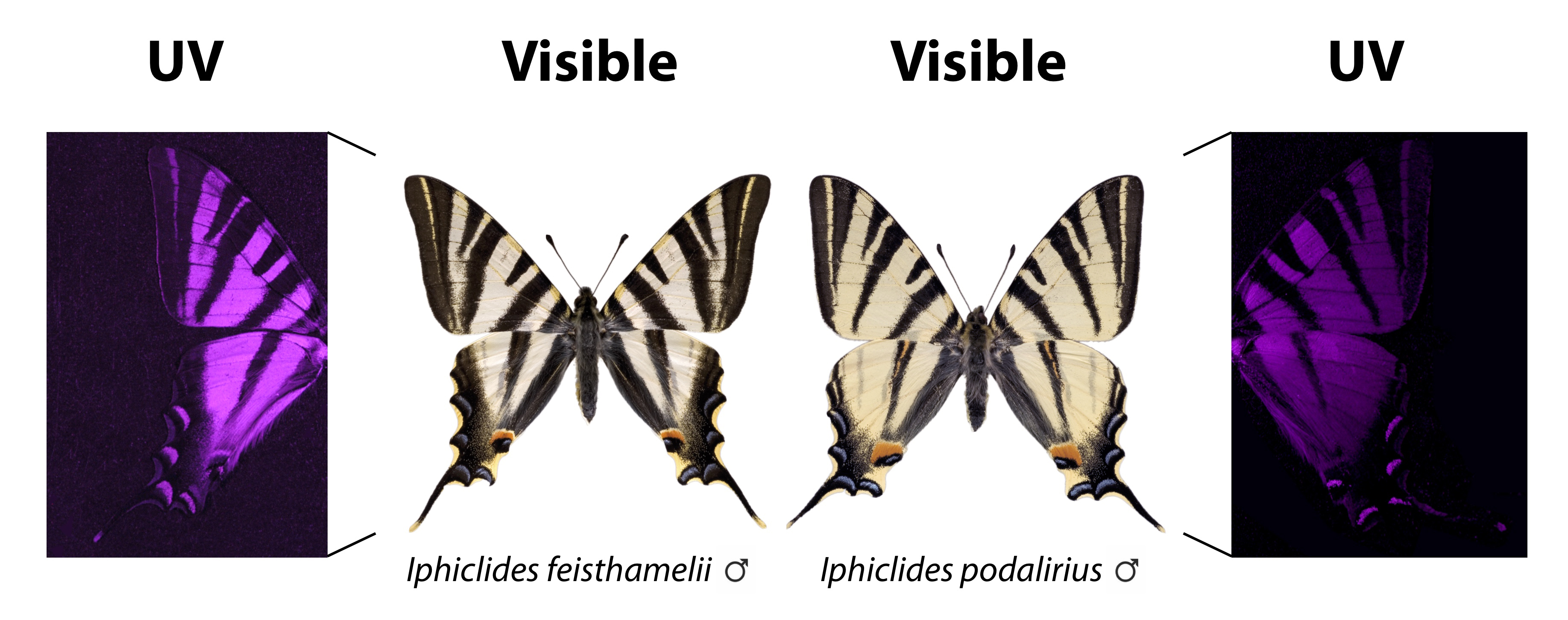La llum ultraviolada revela una nova espècie de papallona
La llum ultraviolada revela una nova espècie de papallona
Investigadors de l'IBE descobreixen que la papallona reina zebrada aranesa es divideix en dues espècies amb mascles idèntics a simple vista però molt diferents sota la llum ultraviolada. Les papallones femella diferencien i trien als mascles de la seva espècie gràcies a la seva visió ampliada més enllà de l'espectre visible humà. La infecció d'un bacteri paràsit va mitjançar una transferència genètica entre totes dues espècies, complicant la resolució d'una confusió taxonòmica que ha durat segles. Aquestes dues espècies podrien emprar-se com a model per a desxifrar els efectes dels bacteris paràsits en l'evolució dels insectes.

Un equip de recerca de l'Institut de Biologia Evolutiva (IBE) a Barcelona, un centre mixt del Consell Superior d'Investigacions Científiques (CSIC) i de la Universitat Pompeu Fabra (UPF), ha descobert que la papallona reina zebrada aranesa es divideix en dues espècies amb mascles molt diferents sota la llum ultraviolada. Les papallones femella, capaces de veure més enllà del visible, probablement identifiquen i trien als mascles de la seva espècie amb què apariar-se a partir d'aquesta diferència de color. La confusió taxonòmica es deu a una transferència genètica entre totes dues espècies mitjançada pel bacteri Wolbachia, que hauria infectat primer a la reina zebrada aranesa i transmès en un encreuament contingut genètic a l'altra espècie - la reina zebrada. Aquestes dues espècies podrien llançar llum sobre com afecten els bacteris paràsits a l'evolució dels insectes.
Dues espècies que han confós als científics durant segles
La papallona reina zebrada és un dels insectes més grans i bonics d'Europa. Malgrat haver atret l'atenció de científics i entusiastes de la naturalesa durant segles, la seva classificació ha estat sempre qüestionada, podent ser una subespècie de la reina zebrada aranesa (Iphiclides podalirius) o bé una espècie independent (Iphiclides feisthamelii). Encara que s'havien observat diferències morfològiques subtils entre elles, les primeres anàlisis genètiques no havien revelat grans diferències. Ara, un nou estudi liderat per Roger Vila, investigador de l'IBE (un centre mixt CSIC-UPF) en el Laboratori de la diversitat i evolució de les papallones, ha confirmat que la papallona reina zebrada pertany a una espècie diferent a la reina zebrada aranesa.
Un descobriment clau: la reflectància ultraviolada de les ales masculines
L'equip de recerca va observar diferències en la grandària i la morfologia dels òrgans reproductors de totes dues papallones, encara que la major diferència la van trobar en les ales dels mascles. Per mitjà de fotografia en l'ultraviolat (UV), van descobrir que les ales masculines de totes dues espècies reflecteixen la llum en aquesta zona de l'espectre de manera diferent (la papallona reina zebrada molt intensament i la reina zebrada aranesa de forma residual). Aquesta diferència va resultar reveladora, ja que no és detectable a simple vista per als humans però sí per a les papallones, que poden veure en aquesta zona de l'espectre no visible. "Com que les papallones femelles són molt exigents en la selecció de parella i tendeixen a acceptar només mascles d'aparença saludable de la seva pròpia espècie, els colors de les ales són clau per a l'atractiu sexual masculí", explica Roger Vila, responsable de l'estudi i investigador principal de l'IBE. Aquesta capacitat per a identificar-se en l'ultraviolat permetria a les papallones comunicar-se entre elles de forma "secreta", esquivant possibles depredadors sense visió més enllà del visible. "Estem començant a entendre com les papallones perceben el món i no deixen de sorprendre'ns els seus superpoders: veuen més colors que nosaltres, poden detectar la llum polaritzada i sentir el nord magnètic, sense esmentar els seus refinats sentits químics", afegeix Vila.
Un bacteri paràsit explica la confusió taxonòmica
L'estudi mostra que el responsable d'aquesta confusió entre totes dues espècies és un bacteri paràsit anomenat Wolbachia. Aquest bacteri viu dins de les cèl·lules dels insectes i, una vegada allà, es transmet per via materna als descendents, igual que l'ADN mitocondrial (que es troba en els mitocondris de la cèl·lula). L'equip de Vila ha descobert que Wolbachia va infectar primer a la papallona reina zebrada aranesa i després la infecció es va transmetre en un encreuament, amb el genoma mitocondrial, a l'espècie germana - la papallona reina zebrada. "La transferència d'ADN mitocondrial entre totes dues espècies a través de la infecció del bacteri ha despistat a la comunitat científica durant molts anys. Ara, l'anàlisi exhaustiva de l'ADN juntament amb les diferències observades en les ales no deixen lloc a dubtes: són dues espècies diferents", conclou Roger Vila. El treball de l'equip obre la porta a que aquestes papallones es converteixin en un model per a estudiar els efectes dels bacteris paràsits en l'evolució dels insectes.
El projecte ha estat finançat per l'Agència Estatal de recerca i per la Comunitat Europea.
Article de referència: Gaunet A, Dincă V, Dapporto L, et al. Two consecutive Wolbachia‐ mediated mitochondrial introgressions obscure taxonomy in Palearctic swallowtail butterflies (Lepidoptera, Papilionidae). Zool Scr. 2019;00:1–13. https://doi.org/10.1111/zsc.12355
